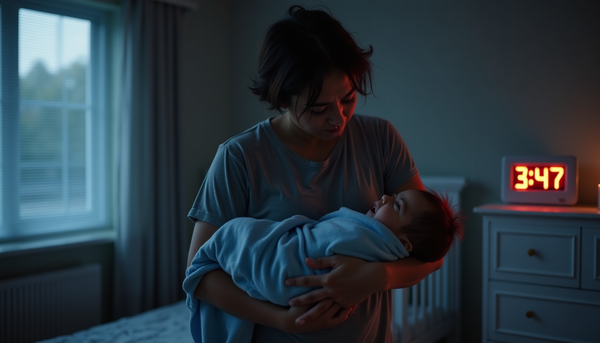The Sleep Training Lie We're All Believing

The Sleep Training Lie We're All Believing
Let me start with a confession that might make some of you close this tab immediately: I sleep trained both my kids.
But here's the thing—I'm also one of those attachment-focused, baby-wearing, co-sleeping-friendly parents who believes in responsive caregiving. Confusing? Yeah, I thought so too until I realized we've been sold a massive lie about what sleep training actually means.
The lie is this: Sleep training equals letting your baby cry alone in a dark room until they "learn" to sleep.
And honestly? That version of sleep training should make you uncomfortable. Because it's not based on how babies actually work.
The False Binary That's Driving Parents Crazy
Somewhere along the way, we got trapped in this ridiculous either/or mentality:
- Either you're a "good" attachment parent who never lets your baby cry
- Or you're a "bad" parent who abandons your child to figure out sleep alone
This binary thinking is not only wrong—it's harmful. It's leaving exhausted parents feeling guilty no matter what they choose, and it's ignoring decades of research about how children actually develop healthy sleep habits.
I've spent the last three years diving deep into sleep research (partly for my work, mostly because my second kid was... challenging), and what I found completely changed how I think about this whole debate.
Why the Harsh Methods Stuck Around (Hint: It's Not Because They Work Best)
Here's something that'll probably annoy you: the reason "Cry It Out" methods are so popular has less to do with child development and more to do with adult psychology.
Think about it—when you're running on 4 hours of broken sleep and your mother-in-law is asking why your 8-month-old isn't "sleeping through the night yet," what sounds more appealing:
- A method that promises results in 3-7 days
- A gentle approach that might take 2-3 weeks
The CIO method appeals to our instant-gratification culture. It's sold as a quick fix. But here's what they don't tell you in those glossy sleep training books: quick doesn't mean better for your child's developing nervous system.
The Science They Don't Want You to Know
Research from Bell and Ainsworth (1972)—yeah, we're going back to the classics here—shows that babies who receive consistent, responsive care actually cry less over time, not more. When we respond to their communication attempts (yes, crying is communication), they learn to trust that their needs will be met.
But when we ignore those communication attempts? The stress doesn't just disappear. It gets internalized.
Dr. Mary Ainsworth's attachment research revealed something fascinating: securely attached children—those whose caregivers responded consistently to their signals—actually became more independent as they grew, not less.
So this idea that responding to your baby creates a "spoiled" or dependent child? Complete myth.
Decoding Baby Communication (Or: Why Your Baby Isn't Manipulating You)
Let's talk about crying for a second because there's so much garbage information out there about this.
Your 6-month-old is not lying in their crib thinking, "How can I manipulate my parents tonight?" That's not how infant brains work. The part of the brain responsible for manipulation doesn't develop until much later.
When babies cry, they're communicating one of these basic needs:
- Physical comfort (hungry, cold, wet, uncomfortable position)
- Emotional connection (need for closeness, reassurance)
- Regulation help (overstimulated, overtired, can't settle)
Here's where it gets interesting: babies who learn that their communication gets a response actually become better at self-regulation over time. Not worse. Better.
The Communication Framework That Changes Everything
Instead of thinking "How do I stop this crying?" try thinking "What is my baby trying to tell me?"
This shift completely changes your approach to sleep challenges. Instead of seeing bedtime crying as a battle to win, you start seeing it as information to decode.
Sometimes the message is "I'm overtired and need help winding down." Sometimes it's "This new sleep location feels scary without you nearby." Sometimes it's "I don't know how to transition between sleep cycles yet."
Once you start listening to the communication instead of just trying to stop it, you can actually address the underlying issue.
The Responsive Sleep Approach That Actually Works
Okay, so if harsh methods are problematic and ignoring crying isn't developmentally appropriate, what do you do when your baby won't sleep?
This is where methods like the Sleep Lady Shuffle come in—and why they're gaining traction among child development professionals.
How Responsive Sleep Training Actually Works
The basic principle is this: you can teach independent sleep skills while still being emotionally available.
Here's what this looks like in practice:
Week 1: You stay close to your baby's sleep space, offering comfort through touch, voice, and presence while they learn new sleep associations.
Week 2: You gradually increase physical distance while maintaining emotional availability—maybe moving your chair a few feet away but still offering verbal reassurance.
Week 3: You continue the gradual transition until your baby can settle independently, knowing you're still responsive if they truly need you.
The key difference? You're teaching skills, not abandoning your child to figure it out alone.
Why This Method Works Better Long-Term
Here's what I've observed both professionally and personally: babies who learn sleep skills through responsive methods tend to be more flexible sleepers long-term.
Why? Because they've learned that sleep is safe, that their caregivers are trustworthy, and that they have the skills to handle temporary discomfort without panic.
Kids who go through harsh sleep training often sleep well initially but struggle more with sleep disruptions later—travel, illness, developmental leaps—because they never learned to self-soothe with the confidence that support is available if needed.
"But What About...?" (Addressing the Objections I Know You're Thinking)
"Responsive methods take too long" Yes, gentle approaches often take longer upfront. But here's the thing—they tend to stick better. With CIO, many families end up having to "re-train" multiple times. With responsive methods, you're building lasting skills.
"My baby cries even with responsive methods" Of course they do. Learning new skills is hard work, even for babies. The difference is they're not crying alone in fear—they're crying with support while developing new capabilities.
"I'm too exhausted for a gradual approach" This one hits me in the gut because I've been there. Sometimes responsive methods need to be modified for family mental health. The goal is finding the gentlest approach that's sustainable for your specific situation.
"My pediatrician recommended CIO" Pediatricians are experts in medical care, but many haven't kept up with attachment and sleep research. It's okay to seek additional perspectives from child development specialists or sleep consultants trained in gentle methods.
The Paradigm Shift We Need
Here's what I want you to take away from this:
Sleep training isn't the problem. Ignoring your child's developmental needs and communication attempts is the problem.
When we approach sleep challenges with curiosity instead of frustration, with responsiveness instead of rigidity, we get better outcomes for everyone involved.
Your baby can absolutely learn healthy sleep habits without experiencing the stress of being ignored. You can absolutely get the rest you need without compromising your values or your child's emotional wellbeing.
But it requires rejecting the quick-fix mentality and embracing approaches that honor both child development and family needs.
Moving Forward: What This Means for Your Family
If you're in the thick of sleep struggles right now, here's my advice:
- Stop feeling guilty about wanting your baby to sleep better. This is a basic need for your whole family.
- Question any method that asks you to ignore your instincts. If it feels wrong, it probably is for your family.
- Look for approaches that teach skills gradually while maintaining connection. These exist, I promise.
- Remember that your response to your baby's communication is building their foundation for emotional regulation. This matters way beyond just sleep.
The sleep training debate isn't really about sleep at all—it's about how we want to raise confident, emotionally healthy humans.
And honestly? I think we can do better than leaving babies to cry alone in the dark.
What's been your experience with different sleep approaches? I'd love to hear your thoughts in the comments—especially if you've found ways to honor both your child's development and your family's need for rest.




